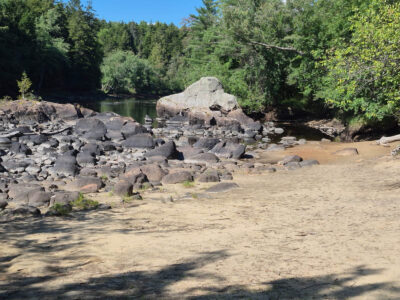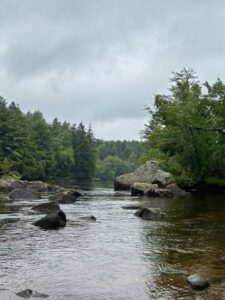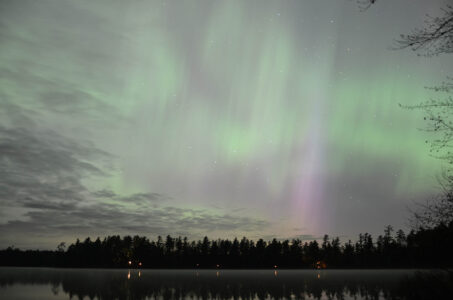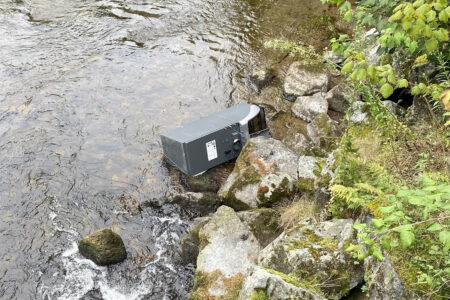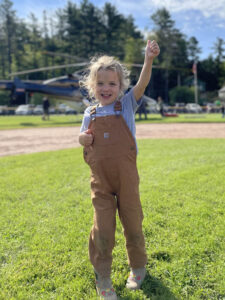Low water, high spirits
90-Miler preparing for trickier course with lack of summer rainfall
- Low water on the Raquette River beneath Raquette Falls is seen on Friday, Aug. 22 in the town of Harrietstown. This renders the usual put-in location along the 90-Miler’s carry around the falls on the Day 2 course unusable — unless water levels rise. (Provided photo — Brian McDonnell)
- The Raquette River is seen here in June at higher water levels. Below, the river is seen from the same vantage point on Sunday with low water levels. (Provided photo — Brandon Devito)
- The Raquette River is seen Sunday at low water levels. Above, the river is seen from the same vantage point in June with higher water levels. (Provided photo — Brandon Devito)
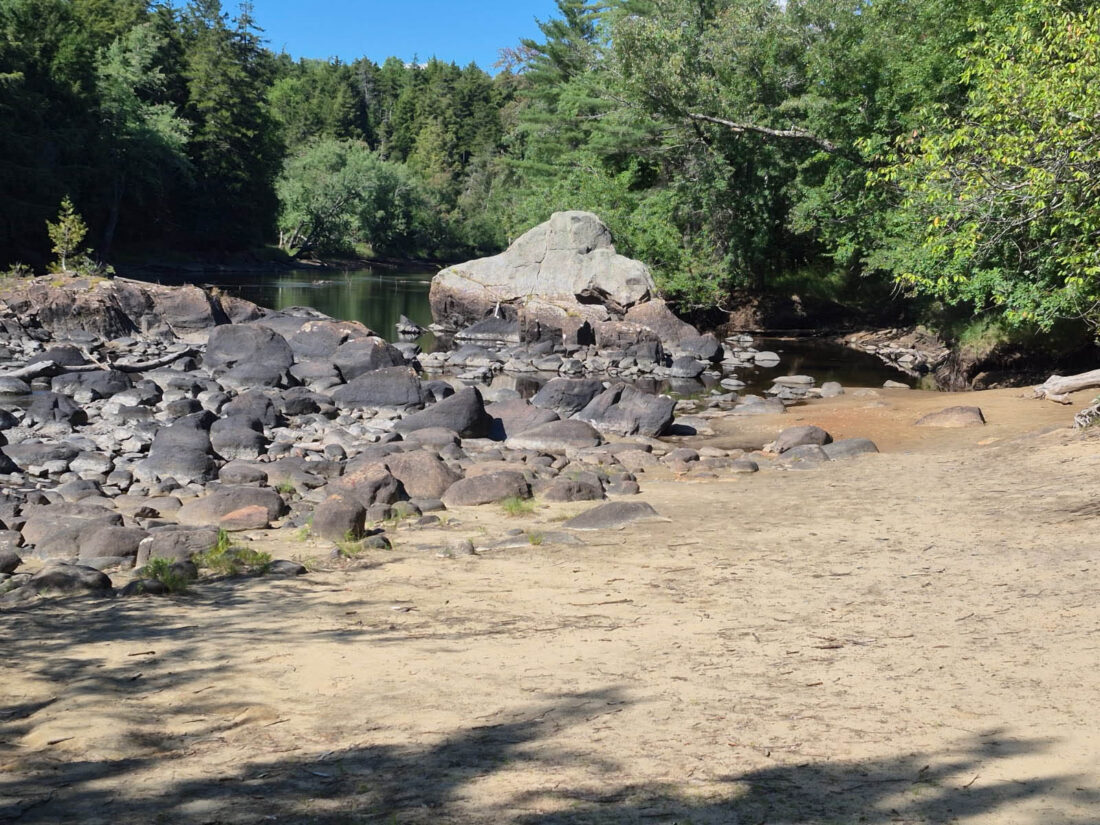
Low water on the Raquette River beneath Raquette Falls is seen on Friday, Aug. 22 in the town of Harrietstown. This renders the usual put-in location along the 90-Miler’s carry around the falls on the Day 2 course unusable — unless water levels rise. (Provided photo — Brian McDonnell)
SARANAC LAKE — With three days until the 90-Miler canoe race kicks off, longtime local paddlers have been getting their practice reps in while scouting course conditions.
The biggest observation — perhaps unsurprisingly, given the weather over the past couple months — has been that it’s an exceedingly low-water year. The three-day race is slated to begin in Old Forge on Friday and end in Saranac Lake on Sunday. The course is a combination of lakes, channels and rivers — linked at times by a series of overland carries.
While the larger lakes aren’t really impacted by low water from a race standpoint, the narrower channels and rivers between them are a different story. Organizers and longtime paddlers say there’s still enough water to run the race, and there will be no alterations to the course. However, the conditions will likely require some adjustments, and etiquette, from racers.
The “90-Miler,” officially known as the “Adirondack Canoe Classic,” is run by the Northern Forest Canoe Trail. Executive Director Karrie Thomas noted that while the water levels are “certainly low” this year, the race will forge ahead.
“For a three-day event that spans a huge section of the Adirondack Park, we’re always at the whims of nature, whether it’s wind, rain, heat, cold or low water,” she said. “Altering the course is not something we consider as it is logistically infeasible. Paddlers are well aware of the water levels and they understand that some sections might require them to slow down and adjust, and that times might be slower than past years.”
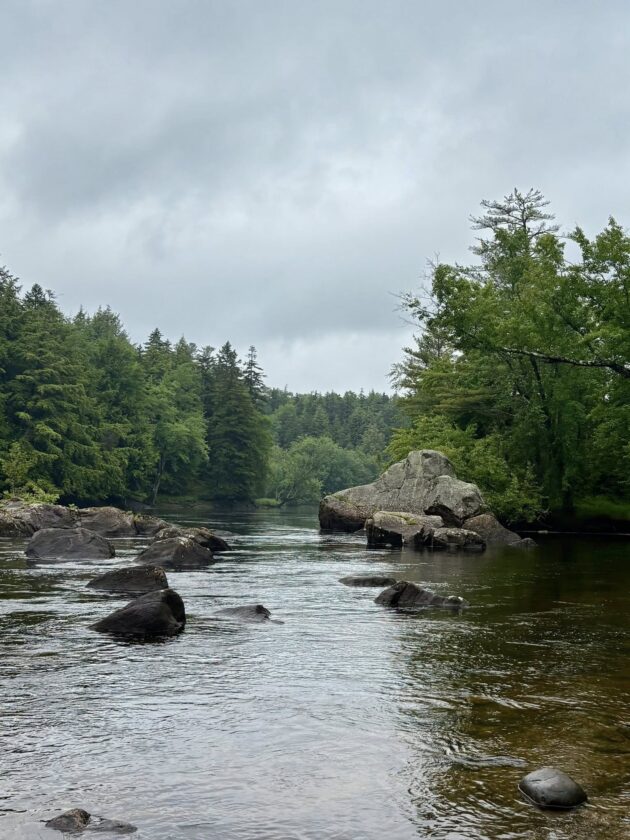
The Raquette River is seen here in June at higher water levels. Below, the river is seen from the same vantage point on Sunday with low water levels. (Provided photo — Brandon Devito)
The race was first organized by Saranac Laker Sue Dyer in 1982. It was then run by Brian and Grace McDonnell, starting in 1999, before ownership and operation were transferred to the Northern Forest Canoe Trail in 2021. This year, there are more than 650 people signed up to race in 280 boats, as of press time Monday.
With over two decades of overseeing the race, Brian McDonnell said this year was shaping up to be among the lowest water level courses he has seen — but that it’s nothing that hasn’t happened before.
“The good news is there’s still water,” he said. “Overall, this is not unique. This is not the first time this has ever happened.”
McDonnell said that with the lower water, the downriver portions of the race — most notably the Raquette River from the north end of Long Lake to the Crusher state boat launch about 3 miles east of the village of Tupper Lake — will have a slower current.
“Nobody is going to break any records this year,” he said.
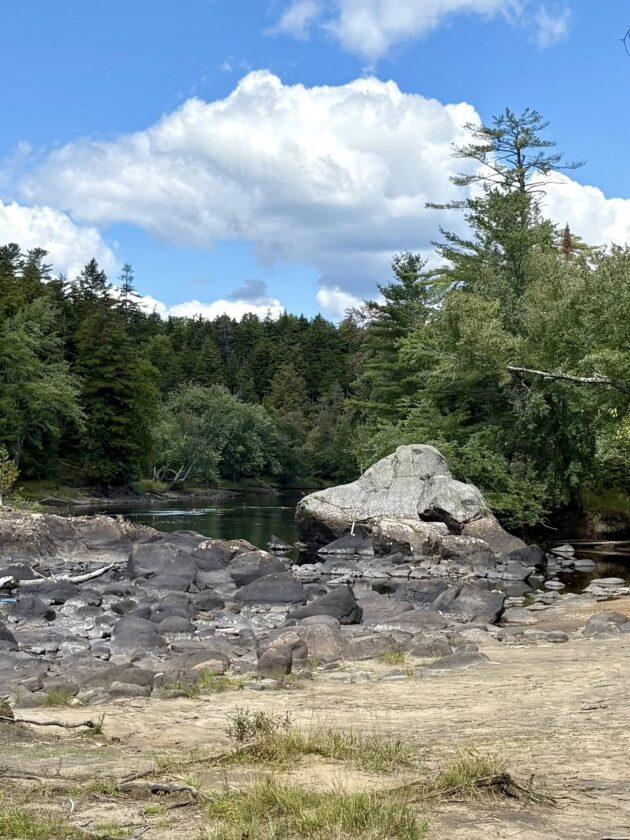
The Raquette River is seen Sunday at low water levels. Above, the river is seen from the same vantage point in June with higher water levels. (Provided photo — Brandon Devito)
In addition to a slower flow, McDonnell, who will be racing this year, as he has the last few years, said there will be more bottlenecks on the course. That’s because the spots where multiple boats could get through at a time in normal or high-water years will be constrained to a “single lane.” Even though the clock will be ticking, McDonnell said these situations will require racers to be courteous of one another and work together to keep traffic flowing as smoothly as possible around those areas.
“It’s just going to be one of those scenarios where people are going to just have to tone it down a little bit and have a lot of sportsmanship,” he said.
McDonnell said this was most likely to manifest on the eastern portion of Seventh Lake, Brown’s Tract and the Marion River on Day 1, the north end of Long Lake and the Raquette River on Day 2 and above the Lower Locks on Day 3.
One benefit, he said, was a robust network of beaver dams along Brown’s Tract retaining some water that would have otherwise flown into Raquette Lake.
“The beaver dams are going to help keep the water level at least reasonable, so it doesn’t turn into a track meet,” he said.
Besides narrower paddling routes on the water, McDonnell said that getting in and out of the water will be a bit trickier this year. The 90-Miler course has eight carries over its three days, with racers hauling their boats over land to get between waterbodies.
McDonnell said that some of the carries’ usual “take-out” and “put-in” spots will be unusable this year due to low water, requiring extensions to the overland carries that aren’t typical. The most significant of which, he said, was likely to be the put-in below Raquette Falls, where he estimated the carry would have to be extended another 100 yards or so to get to sufficiently deep water.
“The course is going to be adapted in ways to make it easier for people to get in and get out of their boats at carries,” he said. “People are going to have to be very aware of the potential for hazards like stumps and rocks and sand bars in different places.”
The boats span 17 unique classes, each with its own age and gender divisions. The watercraft include various specifications of canoes, kayaks, guideboats and stand-up paddleboards. While McDonnell said the low water will be a hurdle for everyone, it will be most difficult for the guideboats.
“The guideboaters, especially, are going to have to be very conscious of not only their boat depth, but also the swing of their oars,” he said. “They’re going to draft fine, but they have a 15-foot wingspan, so it’s going to be a challenge for them to have enough water in places for their oars.”
Although today, Wednesday and most of Thursday are forecast to remain dry as of press time Monday, there might be a bit of last-minute relief.
A cold front is expected to push through the region Thursday night, according to the National Weather Service’s Burlington, Vermont office, which serves northeastern New York. This could potentially bring a soaking rainfall, although the exact amount and its effect on water levels remain too early to predict with much certainty.
“A little rain could go a long way,” Thomas said. “Just not too much.”

